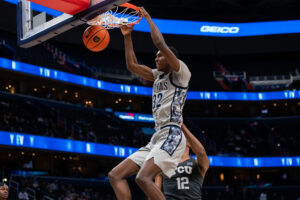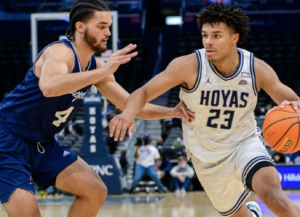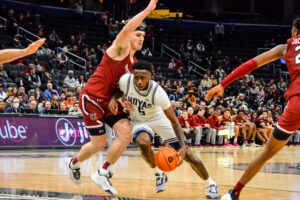There’s no sugarcoating it: We’re doing badly. Really badly. In fact, the Hoyas’ 0-8 Big East record is their worst start to conference play since joining the Big East as a founding member in 1979. While the team shows potential to improve down the stretch, they must answer some serious questions heading into next season.
After Georgetown’s triumph in the 2021 Big East Tournament, Hoya fans had high expectations entering the season. Despite losing Jamorko Pickett, Jahvon Blair, and Chudier Bile to graduation, Georgetown had the number 16 recruiting class in the country, featuring freshman forward Aminu Mohammed, freshman center Ryan Mutombo, and graduate transfer Kaiden Rice. Mohammed is the program’s first five-star recruit since 2014, and Mutombo is both a four-star recruit in his own right and the son of Georgetown legend and NBA Hall of Famer Dikembe Mutombo. Rice was one of the best three-point shooters in Division I basketball last year. Despite their impressive roster, the Hoyas have yet to win a single game in conference play.
The biggest reasons for the Hoyas’ poor performance are easy to spot: defensive breakdowns, an inexperienced roster, and way too many turnovers. Georgetown has often been inefficient on defense this year, leading to tough losses to poorly-ranked teams, including Dartmouth, St. Joseph’s, and Butler. These games should have been easy wins on paper, but something isn’t clicking. Sure, sophomore point guard Dante Harris and graduate guard Donald Carey have missed time due to injury and COVID-19 protocols. Head Coach Patrick Ewing even missed three games due to COVID-19 in January. However, other teams in the NCAA have dealt with the pandemic, and with the Hoyas now at full strength they are running out of excuses.
The Hoyas’ woes started before the season did. In April 2021, center Qudus Wahab, one of last season’s key performers, announced that he was transferring to Maryland. In October, the program announced that Tre King—a transfer center expected to fill Wahab’s spot—would be leaving the roster due to a failure to meet university conduct expectations. These losses stretched the Hoyas’ roster, pushing junior Timothy Ighoefe, junior Malcolm Wilson, and the freshman Mutombo off the bench to fill the gaps.
Those preseason blows showed in Georgetown’s season-opening loss to Dartmouth. The Hoyas overcame a huge first half deficit and pulled ahead 50-48 with 11 minutes to play in the second half. However, they couldn’t keep up their momentum, and lost 69-60 to a 16.5-point underdog. The Hoyas’ play against Dartmouth foreshadowed a trend that has continued throughout the season: a slow start, followed by a run to make things close, only to lose steam in the second half.
Weeks later, Georgetown’s home victory over its bitter rival Syracuse seemed to mark a turning point for the team. Mohammed had career-high stats across the board and the team finally seemed to be gelling. Despite being down 44-34 at halftime, the Hoyas pulled it together, tied things up with 14 minutes left to play, and fought their way to a 79-75 victory. It was the perfect time for the Hoyas to pick up a win over a quality team and build confidence.
Fast forward to today. The Hoyas are riding an eight game losing streak, are underdogs in their remaining 11 games, and are ranked dead last in the Big East.
Overall, the Hoyas’ struggles stem from a combination of weak offense and slow defense. Although they lead the Big East in three-point field goal percentage at 37.8 percent, they have been uncharacteristically weak in scoring near the rim, ranking 10th out of 11 in Big East field goal percentage at a dismal 42 percent. Harris, struggling through several lower body injuries, has regressed on the offensive end of the floor this season. The freshman class has also been largely a disappointment. Tyler Beard, Jalin Billingsley, and Mutombo have lacked the consistency to remain rotation staples, and Jordan Riley was lost due to a torn labrum. Rice, while shooting well from behind the arc, has struggled to play Big East-caliber defense, costing him his spot in the starting line-up.
On the defensive end, the Hoyas have been unable to come up with stops or consistently rebound despite their height, allowing other teams many second chance point opportunities. Georgetown has also been porous in guarding beyond the three-point line, allowing nine or more three-pointers in all but two of their conference matchups this season. If they hope to improve, it’s crucial that they lock down the perimeter.
However, there are some hopeful spots. Mohammed is a budding star. Sophomore forward Collin Holloway has stepped up and is entrenched as the starting power forward. The Hoyas performed well in their recent game against Butler, losing by only 3 points to a team that blew them out 72-58 a few weeks previously. The Hoyas will also welcome junior transfer Wayne Bristol Jr., former MEAC Freshman of the Year, to the Hilltop from Howard. Bristol will hopefully bring some new energy, experience, and defensive depth to the team.
Big offseason questions loom around Ewing and Mohammed. Ewing is in his fifth year as head coach and has brought experience and star power to the program. However, he has not achieved the Big East success many fans expected, attaining a Big East record of 26-52 that is on par with his recent predecessors but disappointing nonetheless. Regardless of whether Ewing stays, the program will face some serious questions about its coaching methodology.
A second question centers around Mohammed’s future with the program. Despite Georgetown’s performance, he has been a standout player and is a possible candidate for the 2022 NBA Draft. If he moves on to play professionally or transfers, the program would be without its star player next year. Coupled with Carey’s graduation, the program would lose two of its main contributors on offense.
There is still hope for Georgetown, but the next few weeks will be crucial. If the Hoyas can bounce back from their abysmal start and regain some confidence, the team will be poised to improve upon their performance next year. However, the outlook for this season is bleak. While last spring was a watershed moment for the program, this season will likely be a disappointment. However, only time will tell whether this season is one more step in a decline into irrelevance or the start of a rebuild on the Hilltop.





